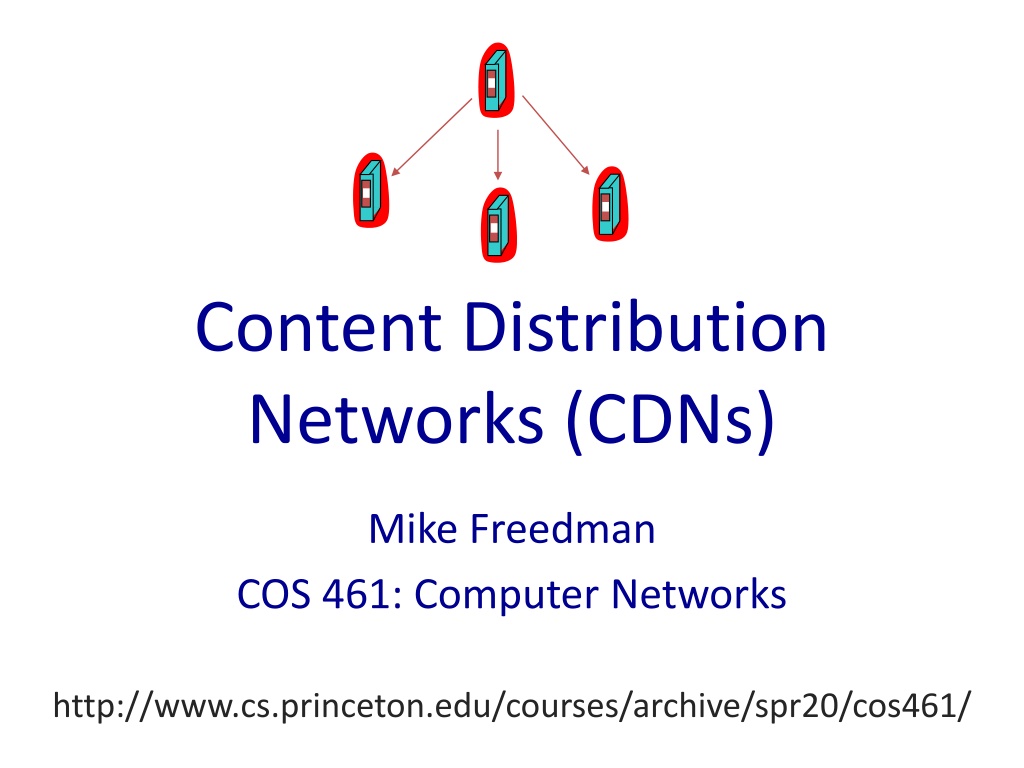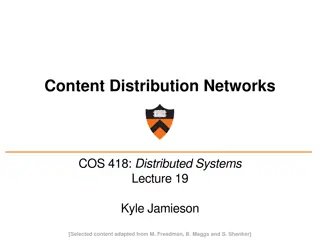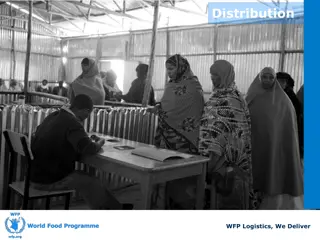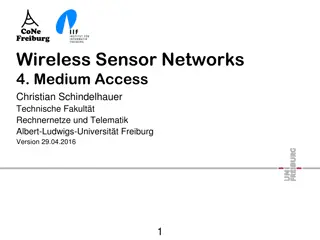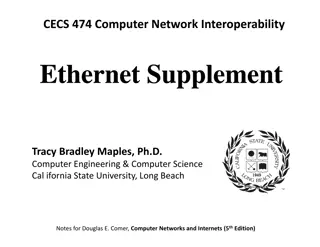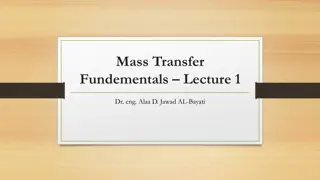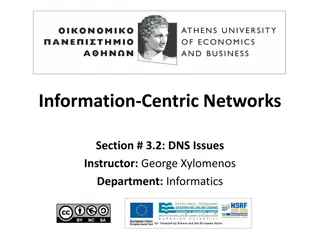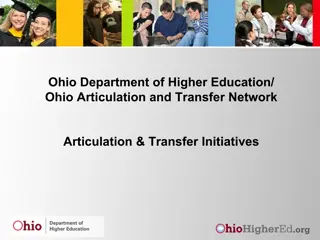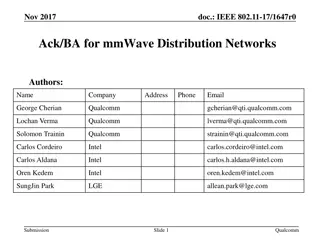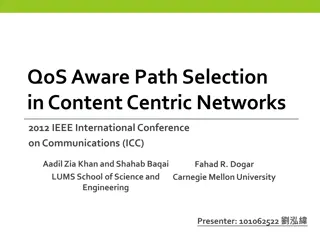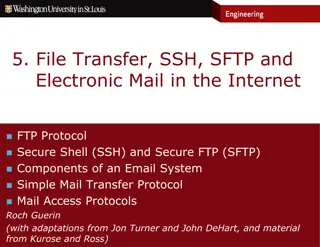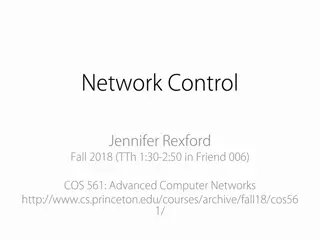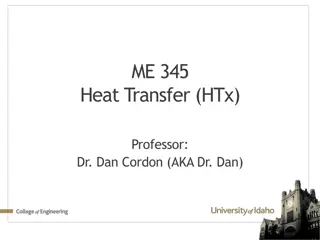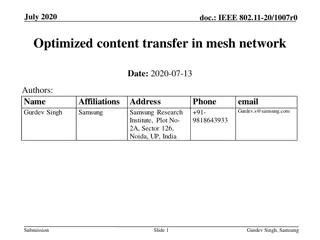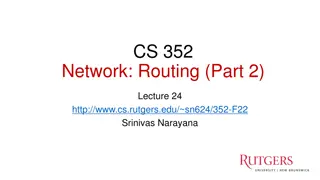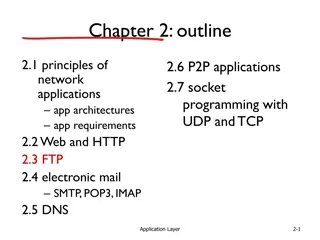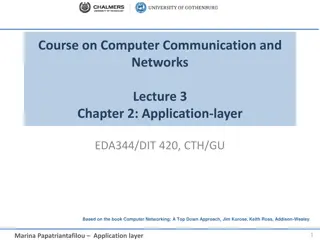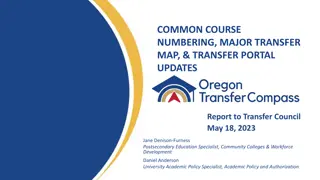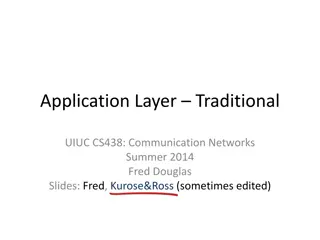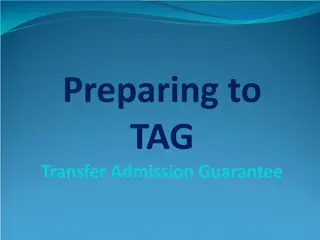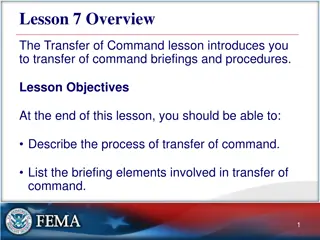Exploring Content Distribution Networks (CDNs) and Efficient Transfer Protocols
Delve into the world of Content Distribution Networks (CDNs) with insights on maximizing goodput, handling multiple requests efficiently, challenges with pipelining, and advancements like Google's SPDY and HTTP/2 for enhanced content delivery over the web.
Uploaded on Oct 08, 2024 | 0 Views
Download Presentation

Please find below an Image/Link to download the presentation.
The content on the website is provided AS IS for your information and personal use only. It may not be sold, licensed, or shared on other websites without obtaining consent from the author. Download presentation by click this link. If you encounter any issues during the download, it is possible that the publisher has removed the file from their server.
E N D
Presentation Transcript
Content Distribution Networks (CDNs) Mike Freedman COS 461: Computer Networks http://www.cs.princeton.edu/courses/archive/spr20/cos461/
HTTP xfer = single object Web pages = many objects
How to handle many requests? Maximize goodput by reusing connections Avoid connection (TCP) setup Avoid TCP slow-start Client-server will maintain existing TCP connection for up to K idle seconds GET / HTTP/1.1 Host: www.example.com Connection: Keep-Alive HTTP/1.1 200 OK Date: Tue, 27 Mar 2001 03:50:51 GMT Connection: Keep-Alive 5
Three approaches to multiple requests Parallel Connections Persistent Connections Pipelined Connections Conn 1: Request 1 Response 1 Request 2 Response 2 Request 3 Response 3 Conn 1: Request 1 Request 2 Request 3 Response 1 Response 2 Response 3 Conn 1: Request 1 Response 1 Conn 2: Request 2 Response 2
What are challenges with pipelining? Head-of-line blocking Small xfers can block behind large xfer No reordering HTTP response does not identify which request it s in response to; obvious in simple request/response Can behave worse than parallel + persistent Can send expensive query 1 on conn 1, while sending many cheap queries on conn 2 7
Googles SPDY -> HTTP/2 Server push for content One client request, multiple responses After all, server knows that after parsing HTML, client will immediately request embedded URLs Better pipelining and xfer Multiplexing multiple xfers w/o HOL blocking Request prioritization Header compression https://developers.google.com/web/fundamentals/performance/http2
Single Server, Poor Performance Single server Single point of failure Easily overloaded Far from most clients Popular content Popular site Flash crowd (aka Slashdot effect ) Denial of Service attack 12
Skewed Popularity of Web Traffic Zipf or power-law distribution Characteristics of WWW Client-based Traces Carlos R. Cunha, Azer Bestavros, Mark E. Crovella, BU-CS-95-01 13
Proxy Caches origin server Proxy server client client 14
Forward Proxy Cache close to the client Under administrative control of client-side AS Proxy server client Explicit proxy Requires configuring browser Implicit proxy Service provider deploys an on path proxy that intercepts and handles Web requests client 15
Reverse Proxy Cache close to server Either by proxy run by server or in third-party content distribution network (CDN) origin server Proxy server Directing clients to the proxy Map the site name to the IP address of the proxy origin server 16
Google Design . . . Data Centers Servers Servers Router Router Private Backbone Reverse Proxy Reverse Proxy Internet Requests Client Client Client 17
Proxy Caches (Y) Forward (M) Reverse (C) Both (A) Neither Reactively replicates popular content Reduces origin server costs Reduces client ISP costs Intelligent load balancing between origin servers Offload form submissions (POSTs) and user auth Content reassembly or transcoding on behalf of origin Smaller round-trip times to clients Maintain persistent connections to avoid TCP setup delay (handshake, slow start) 18
Proxy Caches (Y) Forward (M) Reverse (C) Both (A) Neither Reactively replicates popular content Reduces origin server costs Reduces client ISP costs Intelligent load balancing between origin servers Offload form submissions (POSTs) and user auth Content reassembly or transcoding on behalf of origin Smaller round-trip times to clients Maintain persistent connections to avoid TCP setup delay (handshake, slow start) C C Y M A C C C 19
Modern HTTP Video-on-Demand Download content manifest from origin server List of video segments belonging to video Each segment 1-2 seconds in length Client can know time offset associated with each Standard naming for different video resolutions and formats: e.g., 320dpi, 720dpi, 1040dpi, Client downloads video segment (at certain resolution) using standard HTTP request. HTTP request can be satisfied by cache: it s a static object Client observes download time vs. segment duration, increases/decreases resolution if appropriate 20
Content Distribution Network origin server in North America Proactive content replication Content provider (e.g., CNN) contracts with a CDN CDN distribution node CDN replicates the content On many servers spread throughout the Internet Updating the replicas Reactive by TTL or updates pushed to replicas when the content changes CDN server in S. America CDN server in Asia CDN server in Europe 22
Server Selection Policy Live server For availability Lowest load To balance load across the servers Closest Nearest geographically, or in round-trip time Best performance Throughput, latency, Cheapest bandwidth, electricity, Requires continuous monitoring of liveness, load, and performance 23
Server Selection Mechanism Application HTTP redirection Advantages Fine-grain control Selection based on client IP address GET Disadvantages Extra round-trips for TCP connection to server Overhead on the server Redirect GET OK 24
Server Selection Mechanism Advantages No extra round trips Route to nearby server Routing Anycast routing Disadvantages Does not consider network or server load Different packets may go to different servers Used only for simple request-response apps 1.2.3.0/24 1.2.3.0/24 25
Server Selection Mechanism Advantages Avoid TCP set-up delay DNS caching reduces overhead Relatively fine control Naming DNS-based server selection 1.2.3.4 Disadvantage Based on IP address of local DNS server Hidden load effect DNS TTL limits adaptation DNS query 1.2.3.5 local DNS server 26
Akamai Statistics Distributed servers Servers: ~275,000 Networks: 1,500 Countries: 136 Network Up to 50 Tbps daily 2019 Cricket World Cup: 25.3M concurrent viewers 85% Internet is one network hop from Akamai servers Many customers 50% of Fortune Global 500 https://www.akamai.com/us/en/about/facts-figures.jsp 28
29 How Akamai Uses DNS cnn.com (content provider) DNS root server GET index. html Akamai cluster Akamai global DNS server cache.cnn.com/foo.jpg 1 2 HTTP HTTP Akamai regional DNS server Nearby Akamai cluster End user
30 How Akamai Uses DNS cnn.com (content provider) DNS TLD server DNS lookup cache.cnn.com Akamai cluster Akamai global DNS server 3 1 2 HTTP 4ALIAS: g.akamai.net Akamai regional DNS server Nearby Akamai cluster End user
31 How Akamai Uses DNS cnn.com (content provider) DNS TLD server DNS lookup g.akamai.net Akamai cluster Akamai global DNS server 5 3 1 2 HTTP 6 4 Akamai regional DNS server ALIAS a73.g.akamai.net Nearby Akamai cluster End user
32 How Akamai Uses DNS cnn.com (content provider) DNS TLD server Akamai cluster Akamai global DNS server 5 3 1 2 HTTP 6 4 Akamai regional DNS server 7 8 Address 1.2.3.4 Nearby Akamai cluster End user
33 How Akamai Uses DNS cnn.com (content provider) DNS TLD server Akamai cluster Akamai global DNS server 5 3 1 2 HTTP 6 4 Akamai regional DNS server 7 8 9 Nearby Akamai cluster End user GET /foo.jpg Host: cache.cnn.com
34 How Akamai Uses DNS cnn.com (content provider) DNS TLD server GET foo.jpg 11 12 Akamai cluster Akamai global DNS server 5 3 1 2 HTTP 6 4 Akamai regional DNS server 7 8 9 Nearby Akamai cluster End user GET /foo.jpg Host: cache.cnn.com
35 How Akamai Uses DNS cnn.com (content provider) DNS TLD server 11 12 Akamai cluster Akamai global DNS server 5 3 1 2 HTTP 6 4 Akamai regional DNS server 7 8 9 Nearby Akamai cluster End user 10
36 How Akamai Works: Cache Hit cnn.com (content provider) DNS TLD server Akamai cluster Akamai global DNS server 1 2 HTTP Akamai regional DNS server 3 4 5 Nearby Akamai cluster End user 6
Mapping System Equivalence classes of IP addresses IP addresses experiencing similar performance Quantify how well they connect to each other Collect and combine measurements Ping, traceroute, BGP routes, server logs E.g., over 100 TB of logs per days Network latency, loss, and connectivity 37
Routing Client Requests within Map Map each IP class to a preferred server cluster Based on performance, cluster health, etc. Updated roughly every minute Short, 60-sec DNS TTLs in Akamai regional DNS accomplish this Map client request to a server in the cluster Load balancer selects a specific server E.g., to maximize the cache hit rate 38
Selecting server inside cluster Consistent hashing content_key = hash(URL) mod N node_key = hash(server ID) mod N Content belongs to server s node_key is closest to URL s content_key Content 5 CK5 CK20 N105 Circular ID space Server 105 N32 N90 39 CK80
Adapting to Failures Failing hard drive on a server Suspends after finishing in progress requests Failed server Another server takes over for the IP address Low-level map updated quickly Failed cluster or network path High-level map updated quickly Failed path to customer s origin server Route packets through an intermediate node 40
Akamai Transport Optimizations Bad Internet routes Overlay routing through an intermediate server Packet loss Sending redundant data over multiple paths TCP connection set-up/teardown Pools of persistent connections TCP congestion window and round-trip time Estimates based on network latency measurements 41
Akamai Application Optimizations Slow download of embedded objects Prefetch when HTML page is requested Large objects Content compression Slow applications Moving applications to edge servers E.g., content aggregation and transformation E.g., static databases (e.g., product catalogs) 42
Conclusion Content distribution is hard Many, diverse, changing objects Clients distributed all over the world Moving content towards client is key Reduces latency, improves throughput, reliability Contribution distribution solutions evolved Reactive caching, load balancing, to Proactive content distribution networks 43
